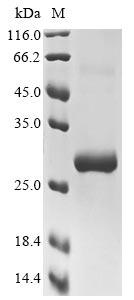Amino acids 769-926 constitute the expression domain of recombinant Mouse Tlr11. This Tlr11 protein is expected to have a theoretical molecular weight of 25.7 kDa. The Tlr11 protein was expressed in e.coli. The Tlr11 gene fragment has been modified by fusing the N-terminal 10xHis tag and C-terminal Myc tag, providing convenience in detecting and purifying the recombinant Tlr11 protein during the following stages.
The mouse Toll-like receptor 11 (Tlr11) is a member of the Toll-like receptor (TLR) family, a group of pattern recognition receptors that play a crucial role in the innate immune system. TLRs recognize conserved molecular patterns on pathogens, activating immune responses. Tlr11 is unique to rodents, and its function is particularly important in recognizing uropathogenic bacteria. Upon ligand binding, Tlr11 activates signaling pathways leading to the production of pro-inflammatory cytokines and type I interferons, contributing to the host defense against bacterial infections. Understanding the role of Tlr11 in the immune response provides insights into the mechanisms of pathogen recognition and may have implications for developing strategies to modulate immune responses in infectious diseases.






